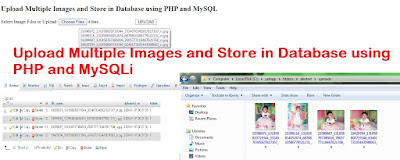Upload Multiple Images and Store in Database using PHP and MySQLi
CREATE TABLE `images` (
`id` int(11) NOT NULL,
`file_name` varchar(255) COLLATE utf8_unicode_ci NOT NULL,
`uploaded_on` datetime NOT NULL,
`status` enum('1','0') COLLATE utf8_unicode_ci NOT NULL DEFAULT '1'
) ENGINE=InnoDB DEFAULT CHARSET=utf8 COLLATE=utf8_unicode_ci;
ALTER TABLE `images`
ADD PRIMARY KEY (`id`);
ALTER TABLE `images`
MODIFY `id` int(11) NOT NULL AUTO_INCREMENT, AUTO_INCREMENT=13;
<!DOCTYPE html>
<html>
<head>
<meta charset="utf-8">
<meta name="viewport" content="width=device-width, initial-scale=1.0">
<title>Upload Multiple Images and Store in Database using PHP and MySQL</title>
</head>
<body>
<?php
// Database configuration
$dbHost = "localhost";
$dbUsername = "root";
$dbPassword = "";
$dbName = "testingdb";
// Create database connection
$db = new mysqli($dbHost, $dbUsername, $dbPassword, $dbName);
// Check connection
if ($db->connect_error) {
die("Connection failed: " . $db->connect_error);
}
if(isset($_POST['submit'])){
// File upload configuration
$targetDir = "uploads/";
$allowTypes = array('jpg','png','jpeg','gif');
$statusMsg = $errorMsg = $insertValuesSQL = $errorUpload = $errorUploadType = '';
if(!empty(array_filter($_FILES['files']['name']))){
foreach($_FILES['files']['name'] as $key=>$val){
// File upload path
$fileName = basename($_FILES['files']['name'][$key]);
$targetFilePath = $targetDir . $fileName;
// Check whether file type is valid
$fileType = pathinfo($targetFilePath,PATHINFO_EXTENSION);
if(in_array($fileType, $allowTypes)){
// Upload file to server
if(move_uploaded_file($_FILES["files"]["tmp_name"][$key], $targetFilePath)){
// Image db insert sql
$insertValuesSQL .= "('".$fileName."', NOW()),";
}else{
$errorUpload .= $_FILES['files']['name'][$key].', ';
}
}else{
$errorUploadType .= $_FILES['files']['name'][$key].', ';
}
}
if(!empty($insertValuesSQL)){
$insertValuesSQL = trim($insertValuesSQL,',');
// Insert image file name into database
$insert = $db->query("INSERT INTO images (file_name, uploaded_on) VALUES $insertValuesSQL");
if($insert){
$errorUpload = !empty($errorUpload)?'Upload Error: '.$errorUpload:'';
$errorUploadType = !empty($errorUploadType)?'File Type Error: '.$errorUploadType:'';
$errorMsg = !empty($errorUpload)?'<br/>'.$errorUpload.'<br/>'.$errorUploadType:'<br/>'.$errorUploadType;
$statusMsg = "Files are uploaded successfully.".$errorMsg;
}else{
$statusMsg = "Sorry, there was an error uploading your file.";
}
}
}else{
$statusMsg = 'Please select a file to upload.';
}
// Display status message
echo $statusMsg;
}
?>
<p><h2>Upload Multiple Images and Store in Database using PHP and MySQLi</h2></p>
<form action="" method="post" enctype="multipart/form-data">
Select Image Files to Upload:
<input type="file" name="files[]" multiple >
<input type="submit" name="submit" value="UPLOAD">
</form>
</body>
</html>
VIDEO











